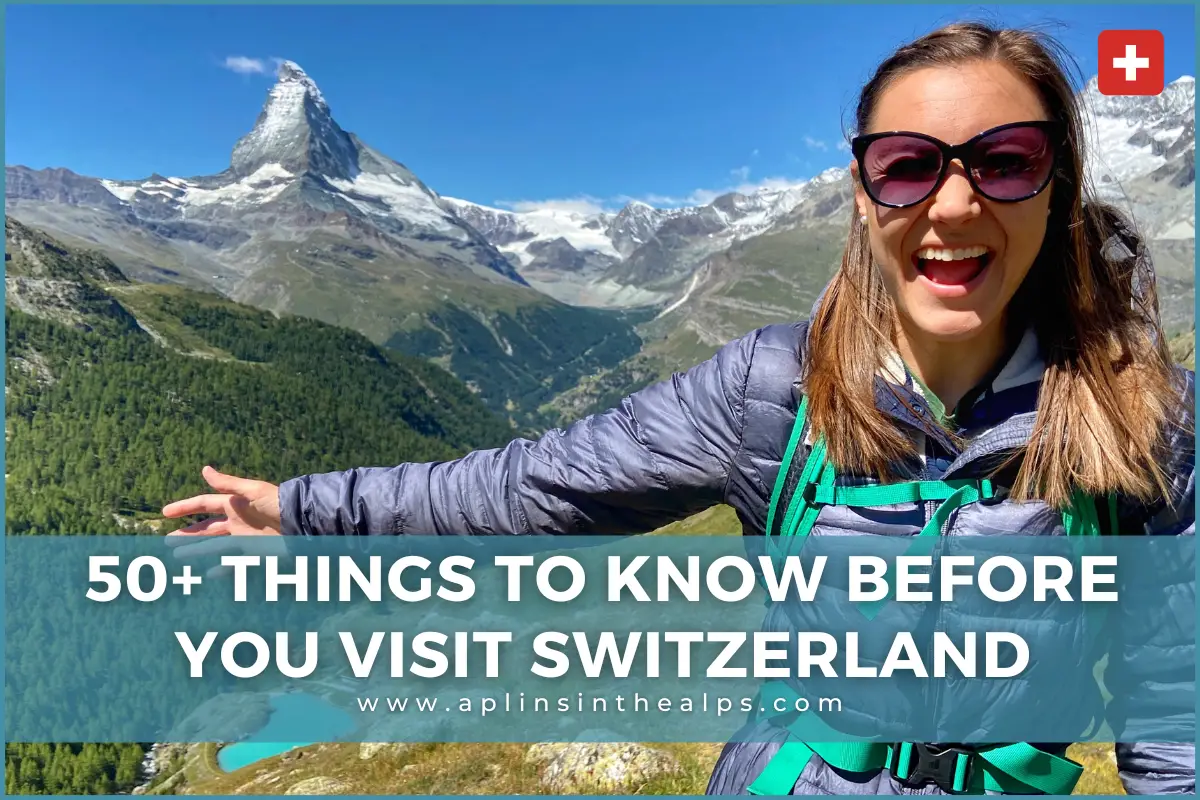If you’re coming to Switzerland for the first time, there are quite a few things you need to know, and a whole lot more that will just make your trip even smoother.
We’re Jana and Brett, and our goal is to help you travel Switzerland with confidence, whether this is your first trip or your tenth. We have 50+ things to cover, so let’s jump right in!
Want to Watch instead of Read?
LOCATION AND MONEY
1 | Switzerland is a land-locked country in Central Europe
Switzerland is a land-locked country located in central Europe, bordered by France, Germany, Austria, Liechtenstein, and Italy.
Though it’s not bordered by an ocean or sea, it does have two large lakes on opposite corners of the country.
2 | Switzerland combines well with trips to other European countries
Because of its location, a Swiss vacation combines well with any of those countries along its border. We always say that a trip to Switzerland and Italy or Switzerland and France is a perfect match because one country offers you endless natural beauty while the other is a foodie destination. But of course, any combination of those countries works great too.
The vast Swiss train network (which we’ll talk more about later) makes it easy to cross borders without having to hop on an airplane. Speaking of borders…
3 | Switzerland is not in the EU
Switzerland is not in the EU, but it is a part of the Schengen Area, which is a group of 27 European countries that allows people with a valid visa to travel through any of those countries for up to 90 days.
And in most cases, once you’re within this Schengen area, you will not need to show your passport in order to cross borders by land (but of course there can be exceptions).
The U.S. is what’s known as a “visa-exempt” country, so if you’re from the U.S., your passport is your visa and there are currently no other special requirements to enter the Schengen Area. But make sure your passport will have at least 3-6 months validity left by the time you’ll leave Switzerland, just to be safe.
4 | ETIAS Entry Requirement beginning in 2025
Starting in 2025, there will be a new entry requirement for all non-European visitors to Europe called the ETIAS application, which is a travel security program used to check criminal records. It’s actually been postponed a few times already, so we’ll see if it’s even implemented by then.
But it’s supposedly going to be very quick, can be completed online, and should only cost a few bucks.
5 | Switzerland uses the Swiss Franc (not the Euro)
Practically, the biggest difference you’ll notice from Switzerland not being in the EU is that they use a different currency: the Swiss Franc instead of the Euro.
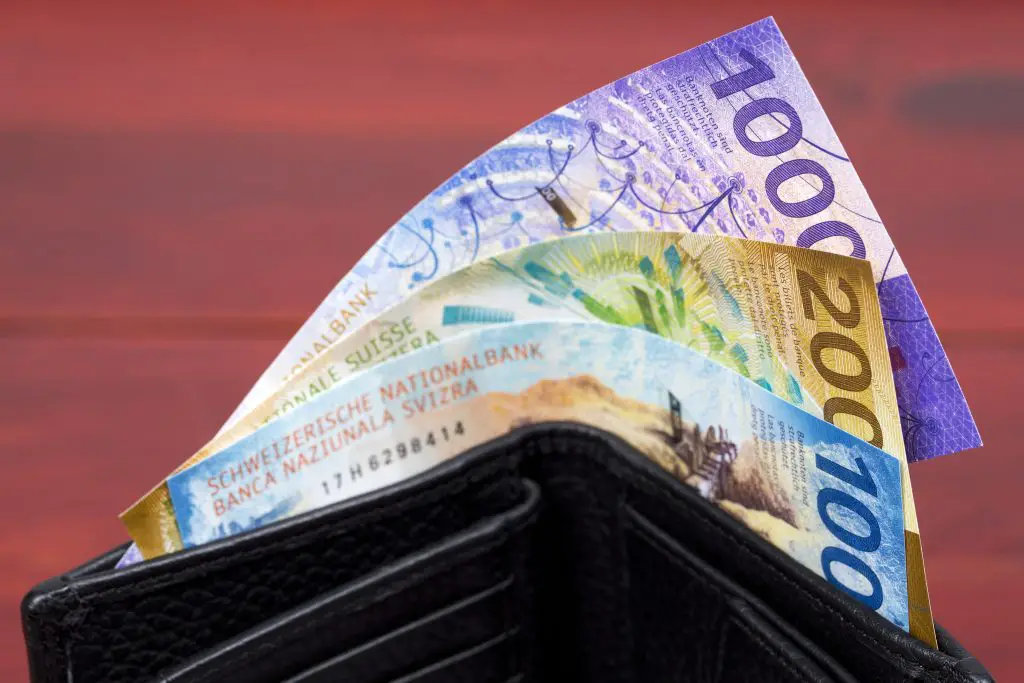
We think the Swiss Franc is more beautiful and fun than the Euro anyway, although we’re probably partial. Just keep in mind that Swiss Francs will not work in other countries. Although Liechtenstein actually uses the Franc, so if you’re going there too, that’s a bonus!
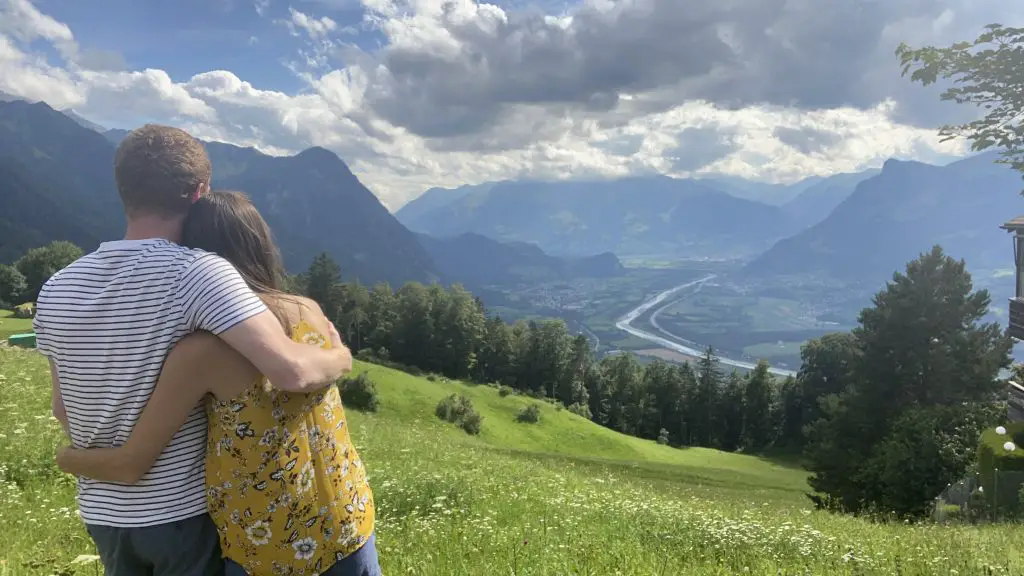
However, your Euros may work in Switzerland. Some Swiss shops will allow you to pay in Euros, but usually the exchange rate is not favorable, so you’ll want some Swiss Francs.
You can order cash in advance or change money at a currency exchange counter when you arrive, but just know that these are usually much more expensive than the actual exchange rate.
6 | Use a Debit Card and get cash from the ATM
So we suggest bringing a debit card and getting cash from an ATM.
While some banks charge a fee for this transaction (called a foreign transaction fee), many don’t. And even with fees, you’ll usually get a better rate at an ATM than a currency exchange counter.
Honestly, your cash needs should be pretty low in Switzerland because credit cards are widely accepted. We recommend starting with 100 CHF for one couple for one week.
You’ll usually only need cash in mountain huts or for those self-service farm fridges we love to shop at, so 100 Francs might even be more than enough.

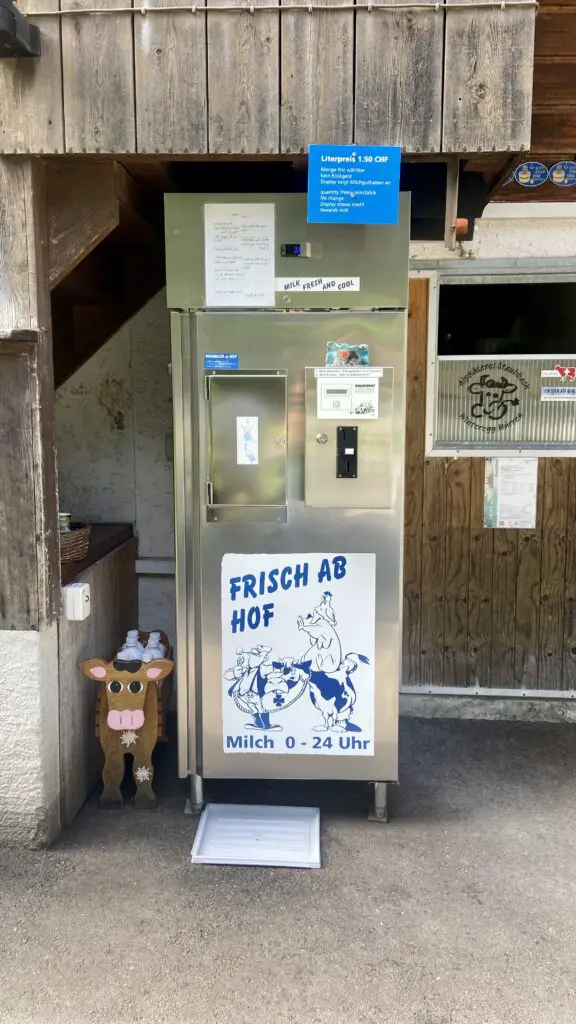
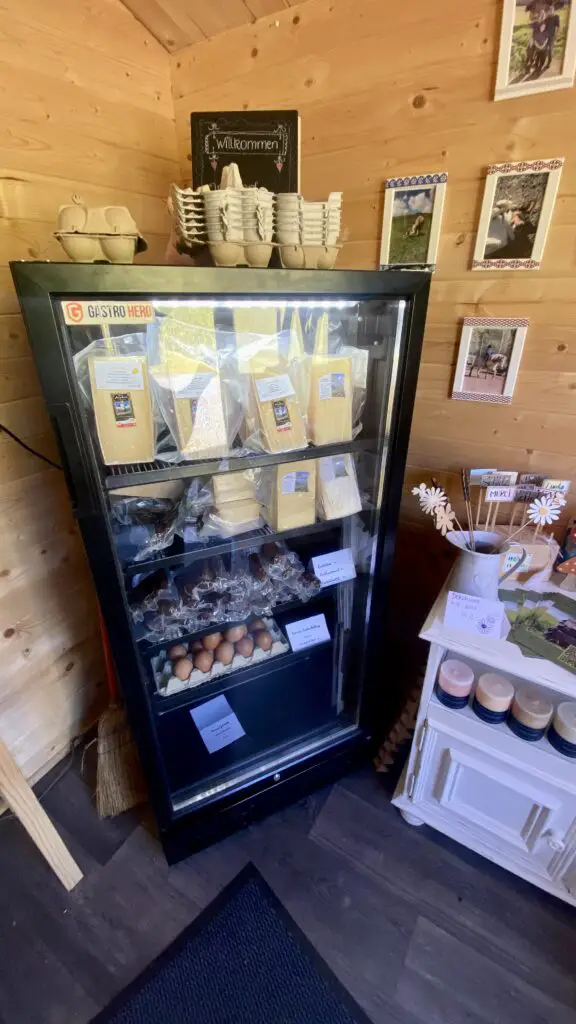
NEXT STEP: Check with your bank about using your debit card in Switzerland, or open an account with a bank that does not charge foreign ATM fees!
7 | Bring two different (non-American Express) credit cards
Speaking of credit cards, bring two non-American Express cards.
Visa and Mastercard are much more widely accepted than American Express, and we suggest bringing two cards just in case one doesn’t work for some reason.
Most companies don’t require you to notify them of international travel anymore, but we do suggest letting your bank know if you plan to use your debit card so your transactions won’t be flagged.
If you can, bring credit cards that don’t charge foreign transaction fees, which will save you around 3%. And if you’re a U.S. resident, look into a travel credit card that will earn you points and miles before, during, and after your trip!
NEXT STEP: Notify your bank about your travel plans so you can use your debit card abroad!
8 | Switzerland is Expensive, but it doesn’t have to be
And all this talk about money raises an important point: Yes, Switzerland is expensive — but doesn’t have to be!
According to the 2019 Travel & Tourism Development Index, Switzerland is one of the least price competitive countries…that’s just a fancy way to say expensive!
But that’s why we’re here, to help you travel Switzerland with confidence, which includes minimizing your budget. So keep reading all 50+ of our tips to learn how to save money, plan better, and maximize your Swiss vacation!
NEXT STEP: Check the exchange rate of the Swiss Franc compared to your home currency
By the way, here are 3 steps to make the most of this info as you plan your trip.
1 | Read this whole blog post, which is loaded with links and recommendations to help you act on what you’re learning.
2 | Buy a done-for-you Swiss Itinerary for the destinations you’re planning to visit, or to make sense of the wacky world of Swiss Transportation.
3 | If you’d still like more personalized help, book a Swiss Vacation Consultation with us.
That’s how to travel Switzerland with confidence in 3 easy steps!
PRACTICAL INFO
9 | Switzerland has 4 national languages
Switzerland has 4 national languages. But don’t let the word “national” fool you: each one is used in different regions, with German spoken most extensively, French mostly in the west, Italian in the south, and Romansh, which only has about 40,000 speakers, mostly confined to parts of the southeast.
10 | English is widely spoken in Switzerland (in the tourist areas)
Will you be okay if you can’t speak one of those languages? Yes, you will find that nearly everyone working in the tourism industry speaks English. So if you have questions, there will be people who can give you answers.
11 | Learn a few phrases in the local language
But not every shopkeeper, and certainly not every local, will speak English. Plus, locals love it when tourists make the effort to speak their language, so we encourage you to learn a few words or phrases.
Of course, you can base that on which regions you’ll be visiting, with hello and goodbye, please and thank you being the most important words to learn.
12 | The “German” is actually Swiss German
But are you ready for a curveball? The “German” spoken in Switzerland is really Swiss German, and even native German speakers struggle to understand it. But don’t let that discourage you. Most of the Swiss will understand you if you speak High German, even if their greetings and responses don’t sound at all like the German you learned!!
13 | Have the right Swiss plug adapter
If you’re traveling to Europe, then you already know that you’ll need a plug adapter. But be warned, the European one doesn’t always work in Switzerland!
Switzerland uses a type J adapter, which is different from the rest of the EU. Some EU plugs, mostly Type C adapters, will fit if the prongs are not too large and the box is not too big. But otherwise, you’ll need another adapter to fit it into a Swiss outlet.
Before you go out and buy one, check if your lodging has any EU-to-Swiss adapters. Otherwise, they’re easy to pick up at most gas stations, grocery stores, and electronic shops, especially ones in the larger train stations.
14 | Enjoy the ultra clean water in Switzerland

Switzerland literally has the cleanest water in the world. As in, it earned a perfect score of 100%. That’s because 80% of the water in Switzerland comes from underground, and the remaining 20% is taken from lakes.
With that in mind, the water from the tap is literally better than bottled water, so bring your own reusable bottle!
By the way, we don’t recommend drinking straight from streams or lakes. And before you take a sip from a fountain, make sure there is a sign that says the water is potable!
15 | Don’t be defeated by Switzerland Weather
I always laugh when my mom texts me and says, “Oh, it looks like you’ll have rain all week.” But I’m standing outside under clear blue skies. That’s because the built-in cell phone weather apps do a terrible job in Switzerland, especially near the mountains.
Instead, we rely on MeteoSwiss and webcams. Here’s our approach:
A few days out, we check MeteoSwiss. This gives us a pretty accurate idea of what temperatures and general weather to expect. The day before, we check MeteoSwiss again. There’s an app and a website, and we prefer the website because it shows a lot more detail, like expected minutes of sunshine or rain per hour. With this info, we can make a good plan for the following day.
The night before and the morning of, we take a look at webcams to make sure the view is clear and the clouds are high, or not even there at all.

Otherwise, pack a good pair of shoes, a solid rain jacket, and plenty of layers so you can get out and explore no matter the weather.
16 | Download and setup Useful Apps before your Swiss vacation
Nowadays, there’s an app for everything. And your Swiss vacation is no exception!
I wish I could tell you about an awesome app by Aplins in the Alps that includes itineraries and weather and time tables, but that doesn’t exist yet. 🙂
Instead, here are 5 apps to download before your Swiss vacation:
- The SBB Mobile App is the ultimate app when it comes to public transportation in Switzerland. You can search timetables and routes, buy tickets, follow your journey, and a whole lot more. In fact it does so much, that we created an entire Guide all about it.
- If you’re going to do any sort of hiking in Switzerland, you’ll want the SwissTopo app to help find and navigate trails, although the trail signs are fantastic and it’ll be hard to get lost.
- We already mentioned MeteoSwiss. Even though we prefer the website, it is convenient to have the app because you can add and save your favorite destinations to view weather at a glance.
- GoogleTranslate is a no-brainer. Download languages offline so you can use the app even if you don’t have data or wifi. My favorite feature is the camera that translates instantly!
- And finally, GoogleMaps is super helpful to know where you are, to find the names of train stations and bus stops, and to save your hotel or Airbnb location.
NEXT STEP: Download the apps above and bookmark MeteoSwiss on your browser
17 | Stay Safe in Switzerland
In addition to being neutral, Switzerland is consistently ranked as one of the safest countries in the world. The most common type of crime is usually tourists getting pickpocketed — so keep an eye on your stuff when you’re in crowded areas.
And it’s not uncommon for there to be accidents in the mountains due to adventure activities, but don’t underestimate the need to be prepared and aware of the elements on even basic hikes.
18 | Save emergency phone numbers in your phone contacts
Hopefully your trip to Switzerland is as smooth as creamy peanut butter. But just in case, we recommend adding a few emergency phone numbers to your phone contacts.
112 is the most important emergency number and will connect you with an emergency operator. It works not only in Switzerland but throughout Europe too, even if you have a foreign SIM card or a prepaid phone with no credit.
If you wanna be ultra prepared, 144 will connect you directly to an ambulance service, and 118 connects you with the fire department. But for non-urgent medical questions, a pharmacy is often the best place to start.
NEXT STEP: Save these emergency numbers in your phone
19 | Switzerland is Family-Friendly
When you think family vacation, you may not think Switzerland, but here’s your cue to think again!
Kids under 6 years old can ride all forms of public transportation in Switzerland for FREE. And from age 6 until turning 16, kids’ tickets are 50% off…unless you have the Swiss Family Card or an equivalent card, and then your kids can ride with you for completely FREE.
Not to mention that everywhere has a playground. And these aren’t just your standard swings and slides. These are epic playgrounds with mazes, giant cows, steep slides, zip lines, tree forts, and hours of fun.
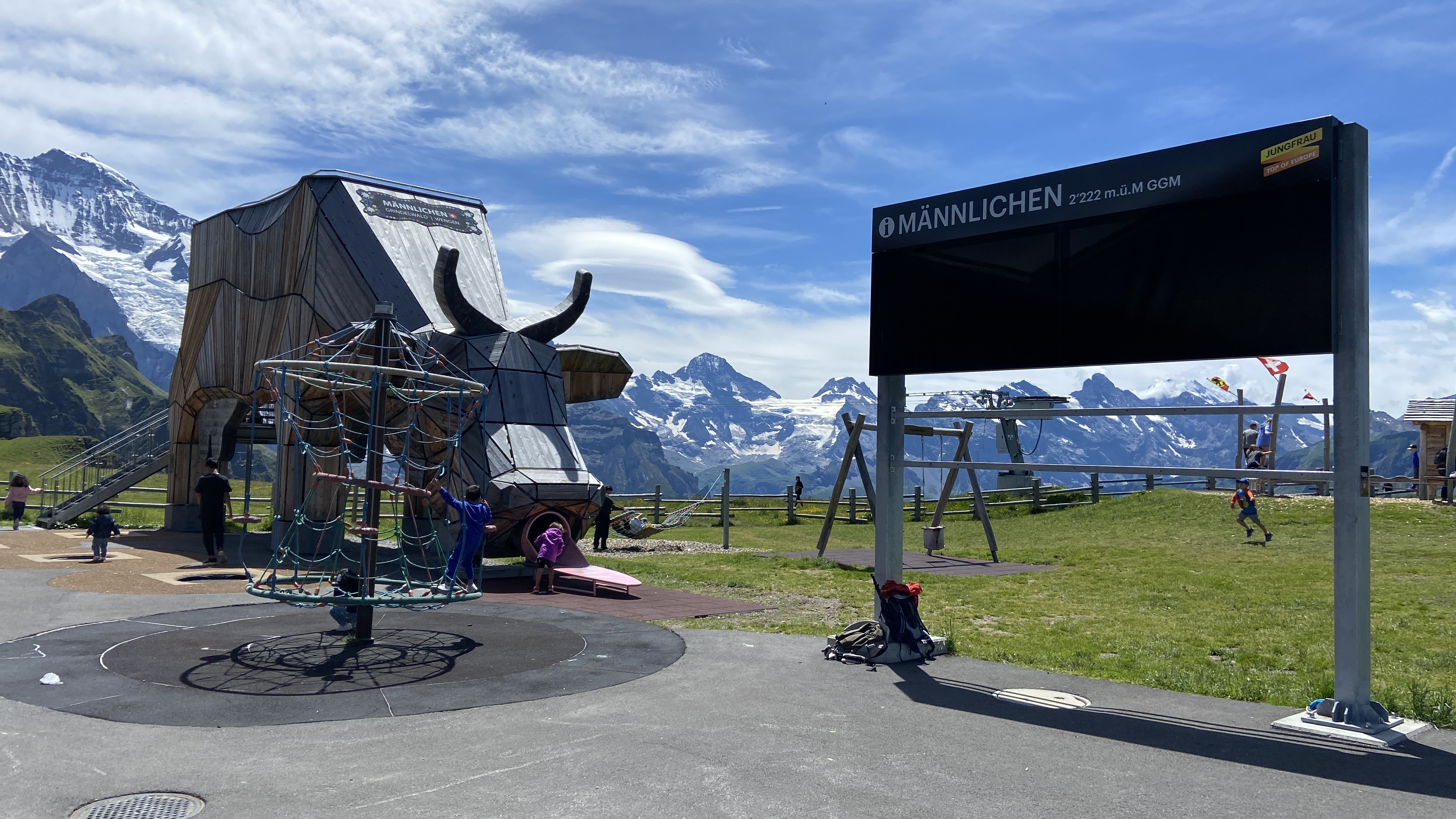


Plus, a lot of restaurants offer a children’s area with toys or games to help keep your kids entertained, as well as children’s menus. Overall, Switzerland is a great place to be a kid!
20 | Don’t count on public Wifi in Switzerland
It seems like wifi is widely available everywhere in the USA, from restaurants to grocery stores and even public parks. But in Switzerland, we’re not that lucky. Thankfully our favorite local and touristy places seem to be picking up on this trend and offering wifi.
Of course nearly all hotels and Airbnbs include wifi. But it’s not always available in cafes, restaurants, or train stations. Sometimes it’s available if you can receive a text, but you’ll need a working cell plan for that.
21 | Get reliable (and cheap) Swiss cell phone data
By far the most convenient and cheapest option for cell phone data in Switzerland is an eSIM. Sure, you can pay 10 bucks a day to upgrade your existing cell phone plan to an international one. But an eSIM is cheaper, super easy to set up, and covers nearly every country in Europe — including Switzerland!
We’ve used Holafly eSIMS across Switzerland and had a great experience and full coverage, even in the mountains!
And this is so much better than having to visit a local shop to buy and swap out a physical SIM card!

22 | Understand basic Swiss Culture and etiquette
As a culture, the Swiss are generally very respectful, helpful, and polite — but not necessarily as outwardly friendly as some other European cultures.
In order to experience their kindness, we recommend offering that same politefulness and respect. Greet them first before ordering food or drink or asking a question. And when your greeting is in their local language, that often brings out even more of their warmth and helpfulness.

Keep in mind that punctuality is a sign of respect too. If you show up 30 minutes late to your dinner reservation, “rudeness” is probably not the reason they gave your table to someone else.
Just remember that you’re a guest in a foreign country that might not function in all the ways you’re used to — not so different from being a guest in someone else’s home.
We find that tourists who are curious and observant, not expecting everything to work just like in their home country, seem to have the best experience.
23 | Avoid showing up to closed shops and restaurants
And one of those things that’s often different — especially compared to the U.S. — is opening and closing times of shops and restaurants.
24/7 convenience is not really part of the culture here. Many shops are closed during the lunch hour, and usually shut down for the day by early evening. Restaurants, cafes, and bakeries will sometimes have breaks between lunch and dinner as well.

Of course in the cities, places are more often open all throughout the day compared to villages and smaller towns. But it’s always a good habit to confirm opening hours if you have your heart set on a specific shop or restaurant.
NEXT STEP: Research when the shops and restaurants you want to visit will be open.
Okay, we’re about halfway through our list, and hopefully you’re already jotting down lots of notes! Our goal is to help you travel Switzerland with confidence, and we wanna make it easy for you. So after you finish reading this blog, take the time to go back and check out the links and action steps to maximize your vacation planning process.
TRIP PLANNING LOGISTICS
24 | Stay Longer
While Switzerland is a pretty tiny country, there is a TON to see. So we recommend spending at least a week here. That’s not just because there’s so much to see and do, but also because a longer trip is often a cheaper trip, at least in terms of how much you spend per day.
Ideally, give yourself 8-15 days, which will allow you to explore a few locations well without wearing yourself out.
And since the Half Fare Card is valid for 30 days for just 120 CHF, a one month trip might be the ultimate sweet spot for a budget traveler — more on that in a moment!
25 | Slow down
We’ve rarely heard of anyone visiting fewer places in a single trip and staying longer in each place — and regretting it! So we want to encourage you to SLOW DOWN.
Slowing down lets you have a more immersive experience…and you won’t need a vacation from your vacation.
So, how many Swiss destinations do we recommend?
Well, for a 7-10 day trip, we’d choose 2-3 places max, plus maybe a night near the airport before we fly back home.
But even with 10-15 days, don’t go crazy…consider 3-4 destinations at most, plus a night at the airport.
Our ideal one-week trip would be to pick a single spot and explore it thoroughly.
Of course more time equals more options, but we always prefer 3+ nights in a location before switching lodging.
26 | Pick destinations that offer a variety of experiences
So, where should you go with your limited time? There are endless incredible places to visit in Switzerland, and you’ve gotta accept you won’t see ‘em all. We recommend narrowing your list to include the Alps, a typical Swiss city, one of the stunning lakes, and at least two of the cultural and linguistic regions.
For the true alpine experience, the 2 obvious choices are the Berner Oberland — which is probably what you picture in your mind when you close your eyes and dream of Switzerland — and Zermatt with its iconic Matterhorn views.

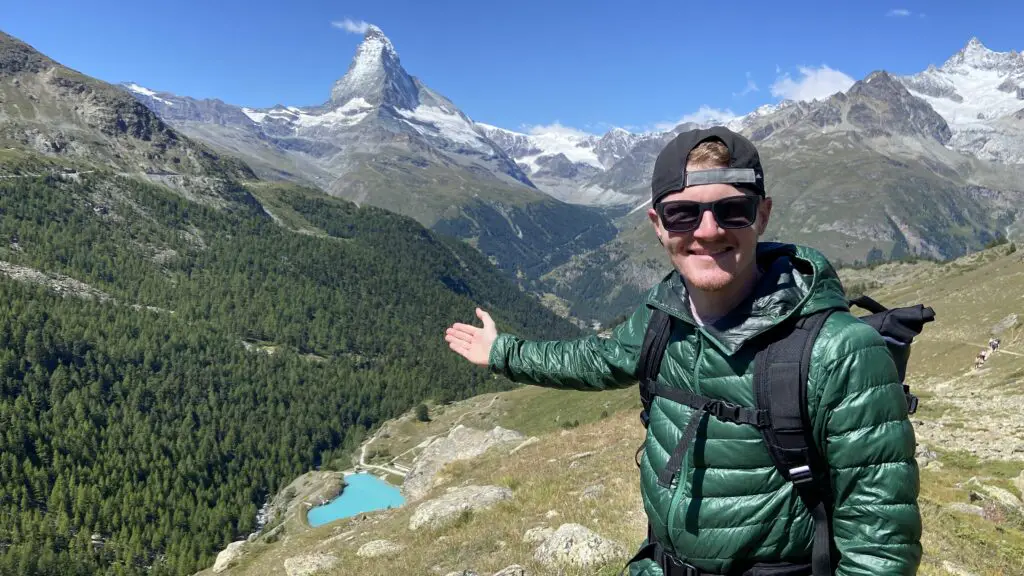
But you can also enjoy mountain excursions while staying in Lucerne, though the nearby mountains typically aren’t as high and dramatic, and there are even plenty of alpine adventures to be had in less-visited areas of the country. Check out our 5 Day Trips from Lucerne Guide where we planned 5 days of these mountain excursions and adventures suited for every type of traveler!
Speaking of Lucerne, we think this is the best Swiss city for a first-time visitor. It’s charming, classically Swiss, and big enough to offer lots of variety without feeling overwhelming.


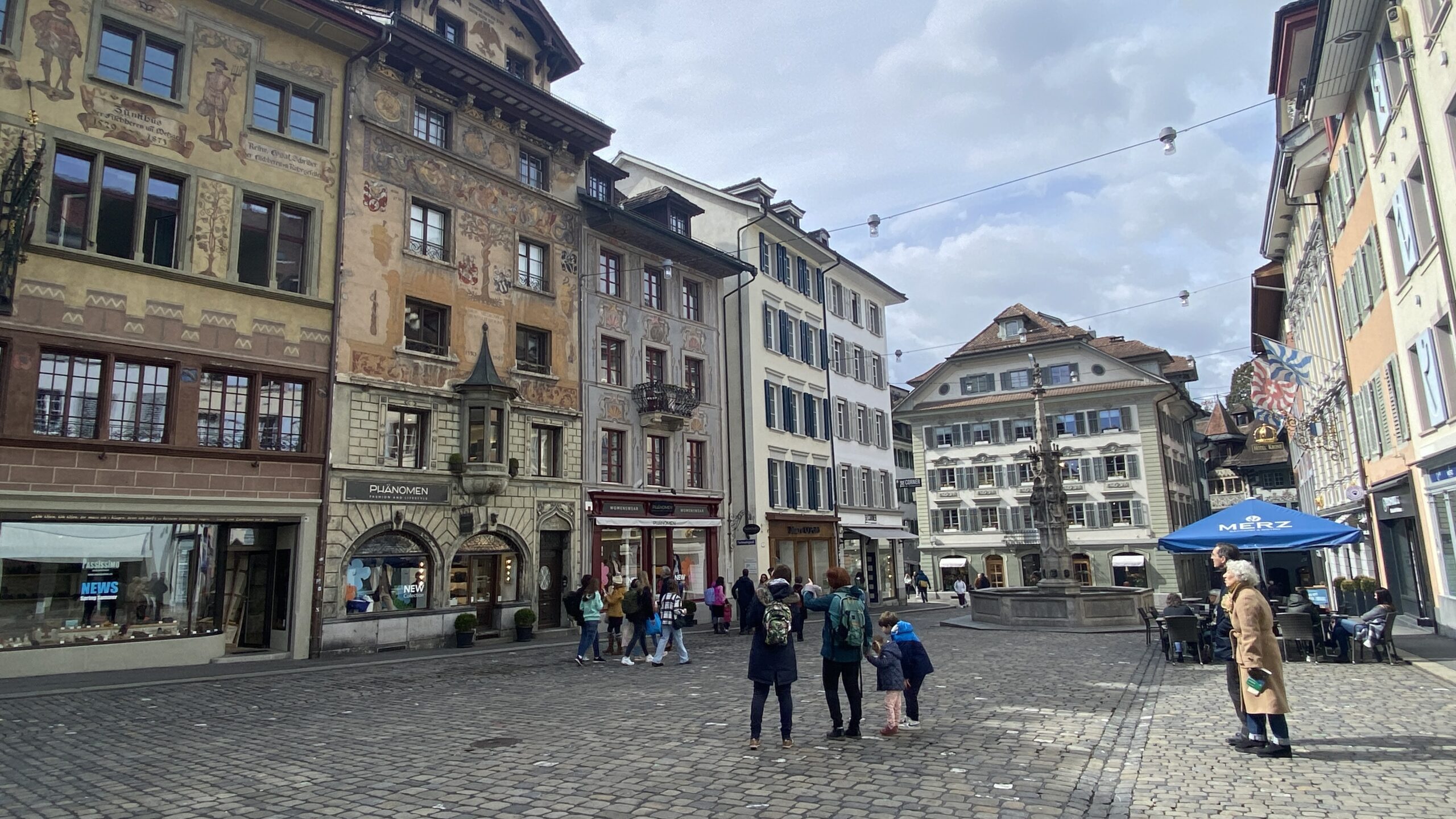


Of course you could check out Zurich, Geneva, or Basel if you’re into big cities, and Bern is a cute smaller Swiss city too. But we still choose Lucerne over all these.
For your lake experience, we love Lac Leman, also known as Lake Geneva. It has castles, cheese tastings, chocolate experiences, the best wine in Switzerland, and because it’s in the French-speaking part of Switzerland, it’ll feel like a different country.
But Lucerne is surrounded by a large lake, Interlaken sits between two lakes, and you could even consider the lakes near the Italian-speaking region of Ticino in the South.
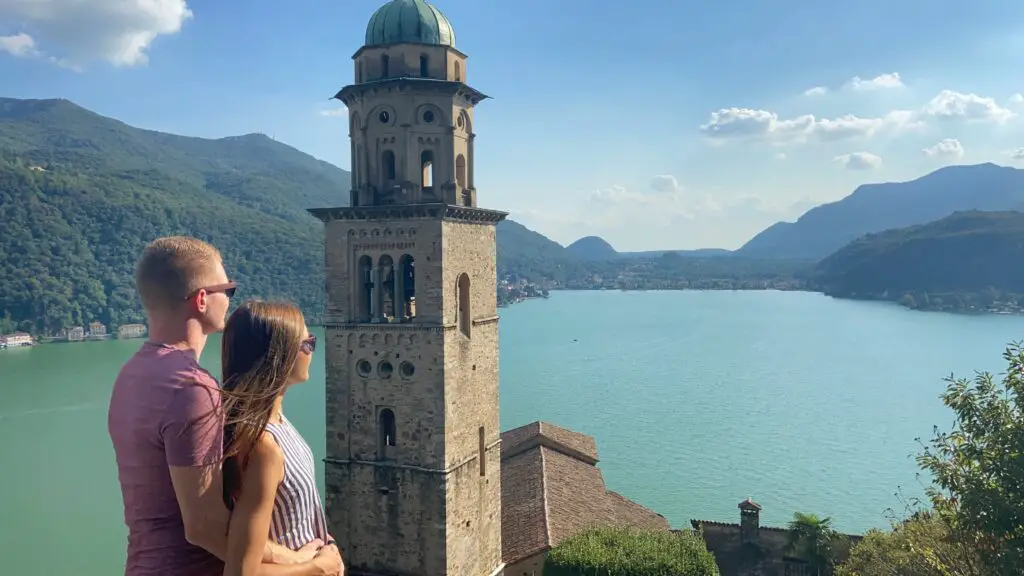

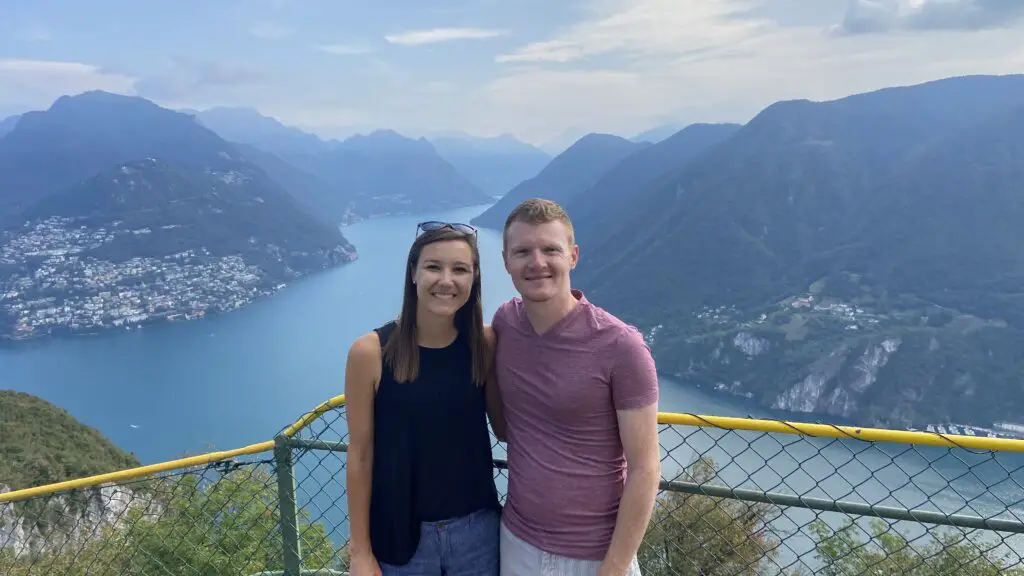
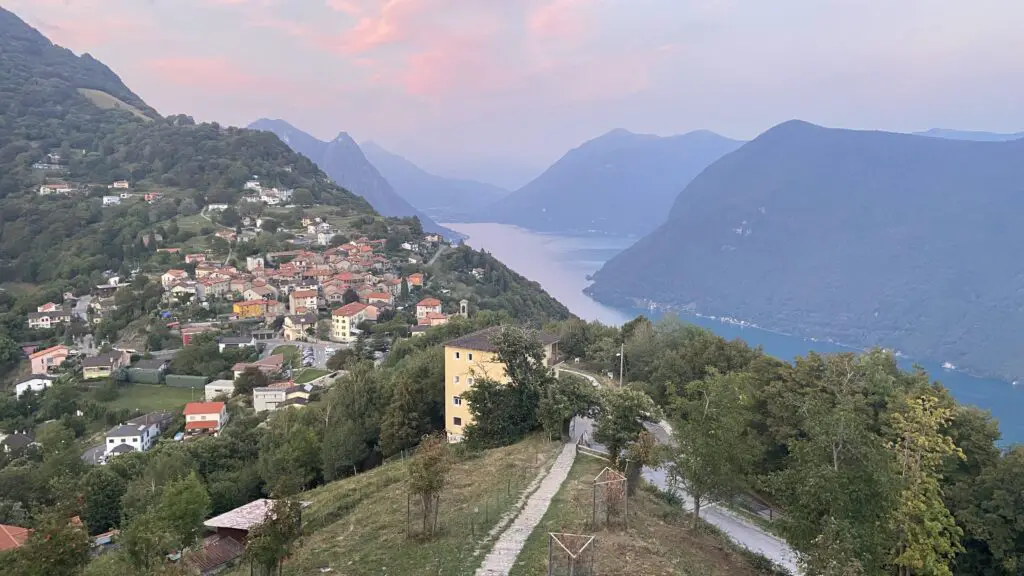
Right now, our favorite combination of places to visit in Switzerland would be Lucerne and Lake Geneva, plus either the Berner Oberland, Zermatt, or both.
But with more time, there’s Appenzell, the Engadin, Emmental, Glarus, Liechtenstein…wow, yeah…just plan on coming back!


27 | Choose the best time of year to visit
In terms of when to visit, there’s really no perfect time; but some seasons are better than others. It really comes down to why you’re visiting: Spring is arguably the most beautiful time of the year for snow-capped mountains, gushing waterfalls, and wildflowers in bloom. But if you wanna hike high in the mountains, it’s probably too early.
Summer — essentially mid-June through August or early September — offers the longest days, warmest temperatures, and clear trails even at high elevations. But it’s also the most expensive and the busiest.
Fall is like Jekyll and Hyde. I think early September through mid-October is my favorite time of the year. Lots of clear blue skies, fewer crowds, and usually plenty of chances to enjoy great hikes in the mountains. But November often brings nothing but clouds and fog.
And then there’s Winter, which is magical when it snows and for the Christmas markets. But you probably know whether or not you want to visit in Winter, so we probably don’t need to say much here.
28 | Know the seasonal closing dates for your most important experiences
Maybe the most important point is to know what will be open and what will be closed during the time you’re thinking of coming, especially trains and cable cars in the mountains. April, May, October, and November are often the months you need to watch out for.
You can find seasonal info on the websites for these specific destinations or transportation companies, and sometimes on regional tourism websites as well.
TRANSPORTATION
29 | Switzerland has 3 international airports
Switzerland has three international airports: Zurich, Geneva, and Basel. If you’re coming from outside of Europe, then Zurich and Geneva are likely your only choices. But from within Europe, Basel is a good option that sometimes offers more budget flights and carriers.

30 | Switzerland is a small country
By most standards, Switzerland is a small country — about 40% the size of our home state of Tennessee!
You can travel from Zurich to Geneva by train in under 3 hours, and from Basel to Lugano in under 4. Which means, seeing multiple parts of the country in a single trip is very doable.
31 | Consider flying into one airport and out of another
And since both major international airports are on opposite sides of the country, consider flying into one and out of the other.
You can put together a really enjoyable itinerary that moves across the country from east to west (or vice versa) to avoid back-tracking and help you spend your time in Switzerland much more efficiently.
NEXT STEP: Determine which airport makes the most sense for your budget and itinerary.
32 | Skip the rental car (in most cases)
So, should you rent a car in Switzerland? Well, it can make sense for larger groups of adults traveling together, or if you’re in the middle of a European road trip and already have a rental.
But you can’t drive everywhere. If you’re visiting the mountains, you will almost always have to ride a train or cable car to reach the top. I can’t tell you how often someone asks us if they can drive to Grindelwald First or Gornergrat…NOPE.
So, our recommendation is to skip the car rental on your first trip to Switzerland.
Keep in mind that it’s often more expensive to pick up or drop off a rental car in Switzerland compared to neighboring countries. So, try to put Switzerland at the beginning or end of a European trip. Or at least organize your itinerary so you can pick up your car rental after leaving Switzerland or drop off it before getting to Switzerland.
33 | Make sure your rental car has a Vignette
But if you do rent a car, you’ll need a “vignette,” a little sticker that goes on your windshield and allows you to drive on Swiss motorways. It costs 40 CHF and is valid for a calendar year.
The nice thing is that there are no toll booths in Switzerland. This vignette is the one “toll” you pay, so you won’t have the unpleasant surprise of racking up more charges than you expect just to drive on the roads.
It’ll probably already be on your car if you rent from within Switzerland, but don’t be surprised if there isn’t one if you’re renting from another country. You can easily buy these at gas stations and rest stops near the Swiss border.
34 | Buy a Swiss Train Pass (or more than one!)
So, with all this in mind, most of you will be riding public transportation during your time in Switzerland. And trust us, you’ll want a train pass!
You’ve probably heard about the Swiss Travel Pass before. But this probably isn’t the best option unless you’re planning a really fast-paced trip covering most of the country.
Keep in mind it doesn’t actually cover everything, despite how it’s marketed. It covers everything at lower elevations, but you’ll usually just get a discount when you travel up into the mountains. That’s why we often recommend the Swiss Half Fare Card plus one of the regional passes (like the Berner Oberland Pass) if mountains are the main reason you’re coming to Switzerland.
You can buy passes online in advance, or when you arrive in Switzerland at an airport or train station, and the price won’t change as your travel dates get closer.
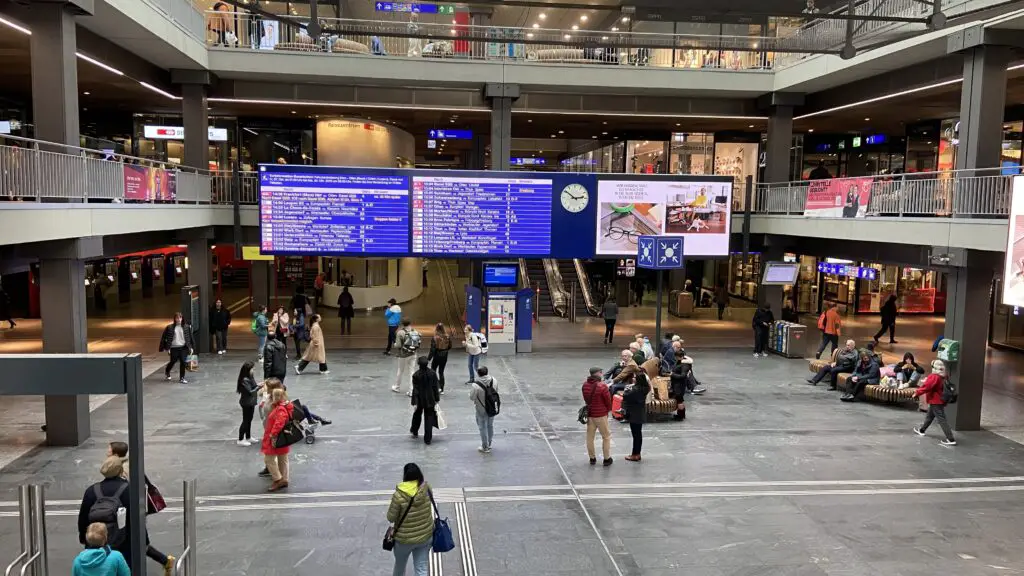
Now it’s impossible to cover the wild world of Swiss train passes in less than a minute, which is why we’ve covered this topic extensively in other videos and resources. If you’re not sure where to start, check out our Swiss Train Pass Checklist to find out exactly which passes are best for your trip!
35 | It’s not just the “Scenic” train rides that are scenic!
Many of you are excited to take a scenic train ride in Switzerland, and there are a handful you might have heard of, the top 3 being The Glacier Express, The Bernina Express, and the GoldenPass.



But before you splurge to ride all 3 or even just one of these, keep in mind that many “normal” train rides in Switzerland are scenic too! So don’t feel like you have to book one of the official scenic trains to enjoy a scenic train ride.
36 | Know if a Swiss scenic train ride actually fits your itinerary
If you really want to ride one of the scenic trains, make sure it actually fits the itinerary you’re planning.
The most convenient is definitely the GoldenPass, which connects Montreux to Interlaken, and there’s even a less popular but very scenic route connecting Interlaken and Lucerne.
So this is a no-brainer for a very efficient itinerary where you fly into one airport and out of the other, and visit Lucerne, Interlaken, and Lake Geneva with no back-tracking.
The Glacier Express and Bernina Express are a little more out of the way. The Bernina Express is a fun route between Italy and Switzerland, but make sure you plan to start or end the Swiss portion of your trip in the Southeast, unless you wanna criss-cross the whole country.
As for the Glacier Express, make sure you actually want to spend 8 hours on a train! You’ll be riding a lot of trains during your trip (unless you’re renting a car — which we already discussed), so this might be a bit much for you unless you’re really into the journey.

Speaking of scenic trains, check out our top 21 rides that we think need to be on your Swiss transportation Bucket List!
37 | Book a Seat Reservation for the scenic trains in Switzerland
And keep in mind that the popular scenic train rides almost always require you to book a seat reservation in advance, in addition to having a valid ticket or train pass when you travel.
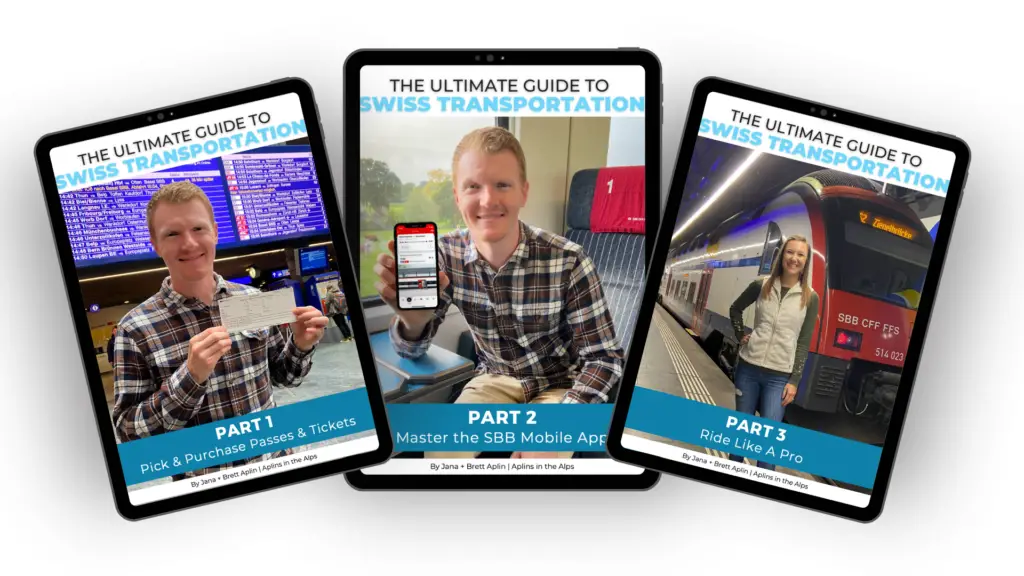
38 | Don’t over-do the Adventure activities in Switzerland
In case you haven’t heard, Switzerland offers endless adventure activities like paragliding, mountaineering, canyoning, skiing, rafting, biking, and ropes courses.
We can already see you adding these adventures to your bucket list, but here’s the thing: limit them unless you’re just an adventure sports enthusiast! They are a great way to blow your budget.

39 | Hiking in Switzerland is the best free entertainment
If you’re like us, then hiking is the best entertainment — and it’s free once you get there! There are more than 65,000 km of trails in Switzerland. So whether you wanna walk for 15 minutes or hike for 5 days, there’s a path for everyone!
Yellow trails are the easiest, and you can walk these in plain tennis shoes. Yellow trails often convert to pink trails in the winter, which are also easy routes for a walk through the snow.
Red and white trails are standard mountain trails that require a solid hiking shoe and average fitness. (Well, average by Swiss standards, which means good fitness!)
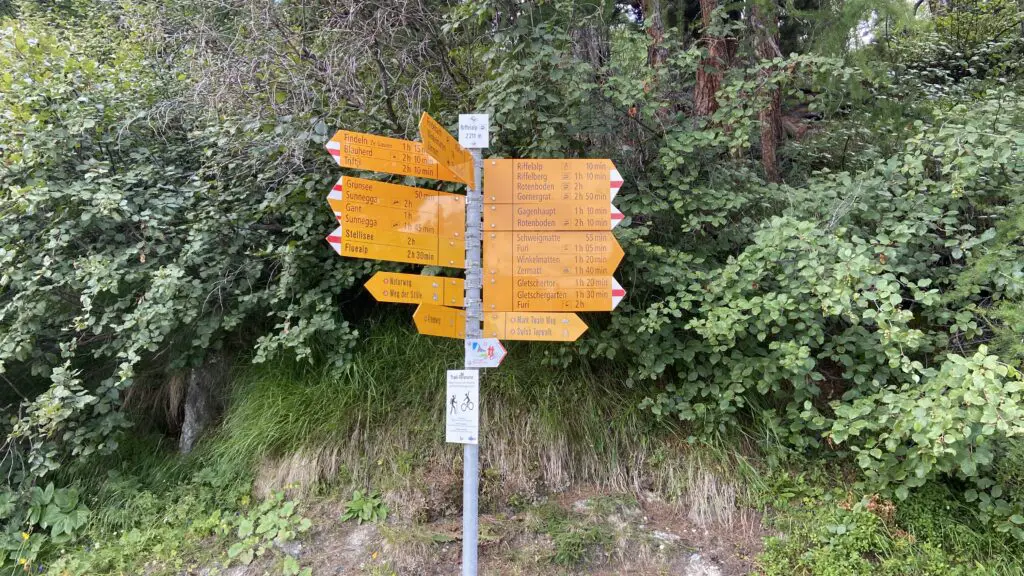
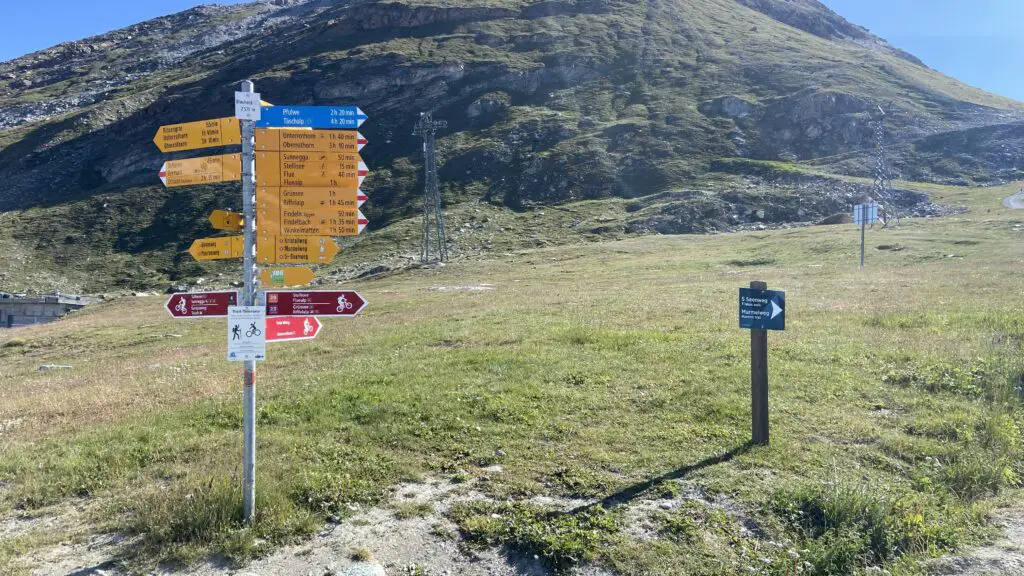
Alpine trails are blue and white, and we don’t recommend you take these routes without a guide or climbing gear since they often cross glaciers and snow and very exposed areas.
40 | Get discounts on sightseeing in Switzerland
Hiking may be free, but what if you want to visit a museum or book a tour? Before you book, see if you are eligible for a discount!
The Swiss Travel Pass and many regional passes offer free or discounted prices for museums and other activities. And Guest Cards, which we will talk about in a later section, often provide free local travel and reduced rates for nearby attractions.
41 | Do you need to make reservations in advance?
If you’re booking a scenic train ride experience, you need to reserve your seats in advance, usually available starting 90 days out. But for other train rides, you do NOT need to book in advance because the price won’t change as the departure gets closer.
For mountain excursions, we don’t think it’s worth booking a tour. Why? Because you can already reach the destination yourself using public transportation. And most of the time, you can follow the trail signs to take your own hike too.
But if you’re eager for outdoor adventures like the ones we mentioned earlier, then yes, absolutely book a tour! And the bookings tend to fill up quickly, so it’s best to book in advance. We love to book through Get Your Guide because they have great prices and packages.
LODGING
42 | Save on Airbnbs with long stay discounts
Once you’ve chosen your destinations, it’s time to start looking at lodging, and your biggest choice will be between hotels and other accommodations like Airbnb.
We prefer Airbnb when we stay 3 or more nights, especially outside of major cities. We like to snag discounts when we stay for a week, and have even taken advantage of 40% off on stays of 28 nights or more.
A discounted Airbnb booked for 1 month plus the Half Fare Card we mentioned earlier? Now, those are the keys to a long yet budget-friendly experience in Switzerland!
43 | Save on Hotel stays with HotelCard
But for short stays, you’ll often save money by booking a hotel. For example, HotelCard (which we personally use all the time for travel in Switzerland!) can earn you discounts up to 50% off the normal prices.
And while there’s a fee to become a member, most people recoup that cost with just a one-night stay, and you can save 30 CHF by signing up with our link.
44 | Tourist tax is charged on top of the nightly rate
Keep in mind, you’ll always have to pay tourist tax when staying at any hotel or Airbnb, and this is usually around 2-6 CHF per person per night on top of the lodging cost, though children are usually cheaper.
Some Airbnbs will require this payment in cash, but most hotels allow it to be paid by credit card.
45 | Guest Cards and Visitor Cards
But that tourist tax will sometimes get you a complimentary Guest Card when you stay in a hotel or Airbnb, depending on the destination.

Often, this covers free local transportation and gives you discounts to some local attractions, although this varies from city to city. In our opinion, the most beneficial thing about Guest Cards is the free local transportation. But keep in mind that “local” really does mean local, so your guest card won’t replace your need for a train pass.
46 | Stay just outside of a popular area to save more money
If you’re trying to save money and are willing to forego a little convenience, you’ll often find cheaper lodging prices just outside of the main areas. This could mean an Airbnb that’s a 10-minute walk from the train station instead of right next door, or a smaller village next to a larger town.
Especially if you’re staying in an area that offers a local Guest Card, you might be able to stay somewhere one train or bus stop from the main area you want to explore for a much cheaper price, AND enjoy free rides covered by the Guest Card.
But the number one way your lodging will save you money has nothing to do with location…so let’s talk about food.
FOOD
47 | Swiss Food is high quality, but not a great value
Food in Switzerland is more expensive than any of the 30+ countries we’ve visited in Europe. The quality is great, but we just don’t consider it to be a good value — especially in German-speaking Switzerland, where the options generally aren’t as interesting or varied as the French and Italian speaking parts.

48 | Book lodging with a kitchen
So, try to book lodging with a kitchen. You’ll save so much money by eating at your apartment instead of in restaurants. In fact, your savings might literally be enough to pay for your lodging!
And if you’ll be visiting France or Italy during your trip, save your food budget for those countries!
49 | Shop at Swiss grocery stores
Shopping at the grocery store is both a budget-friendly experience, and a fun travel experience.
Aldi and Lidl are the cheapest ones you’ll find in Switzerland, but since they’re German stores, not many of the Swiss shop there 🙂
Migros and Coop are the biggest Swiss supermarkets, but tend to be a little more expensive. But if you shop their store brands or look for sales, then you can often find really good value.
Finally, even if you don’t want to cook on vacation, there are great takeaway options for picnics or food-on-the-go. And there’s enough variety, especially in larger stores, that you won’t have to eat the same thing over and over!
And you can find plenty of Swiss brands and local or regional products that will make it feel like a special experience anyway.
NEXT STEP: Find out which grocery store(s) is closest to your lodging!
50 | Enjoy food experiences on the cheap
Speaking of special food experiences, those don’t have to happen in a restaurant. We spend most of our non-grocery food budget in bakeries and cafes.
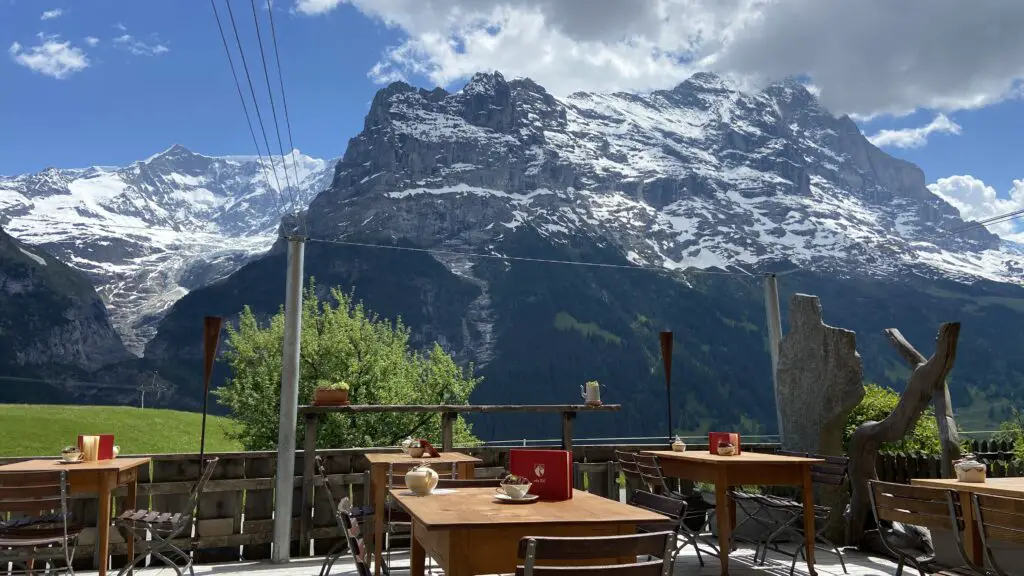
One, because I love coffee and have a pretty serious sweet tooth. Two, because we can enjoy going out for a food experience at a fraction of the price of eating in a restaurant.
And when only a restaurant will do, look into apps like The Fork and Too Good to Go. The first helps you find great discounts for eating IN restaurants, while the second offers even better discounts if you’re willing to do takeaway.
NEXT STEP: Download both of these apps onto your phone and search the available options in the areas you plan to visit.
51 | Splurge on the Must-eat Swiss foods
But don’t spend your ENTIRE trip avoiding restaurants. Make sure you enjoy some of the classic Swiss food such as:
- Fondue or raclette
- Swiss cheese in general
- Rösti
- Sausages
- Beers
- Rivella
- Kambly cookies
There are so many possibilities, we’ll have to save them for a future video!
52 | Try LOTS of Swiss Chocolate
But of course, one of the most important Swiss food experiences is tasting the chocolate! You can create your own tasting by buying Swiss chocolate from a few different brands: Lindt, Frey, Halba, and Cailler, just to name a few. You can find these in just about any grocery store for much cheaper than the fancy box sets you’ll see in tourist shops.
But venture beyond plain chocolate bars too. There’s Toblerone (of course), Ovomaltine (which is a little like a Crunch bar), Torino (which has a chocolate exterior filled with hazelnut cream), and Ragusa (which is similar to Torino but has hazelnuts as well).


Basically, indulge in as much Swiss chocolate as you can!
53 | Make Dinner Reservations
We generally recommend that you make restaurant reservations for dinner, if you have a specific place you want to eat. But it’s less important to reserve a table for lunch, especially if your plans for the day are more flexible.

You can usually make reservations the morning of or the day before by stopping by the restaurant or calling ahead.
54 | Tipping in Switzerland is appreciated, but not expected
Tipping is practically another language because it’s different in every country you visit. But here in Switzerland, tipping is not expected. If you had great service or outstanding food, you can round the bill up to the nearest 5 or 10 Francs.
But make a note that if you’re paying by credit card and want to include the tip on your bill, you will need to tell the waiter or waitress before they run your credit card. That’s because there is usually not a place on the receipt to add the tip afterwards!
55 | For more tips, Buy a done-for-you Swiss Itinerary!
Speaking of tips, we’re just getting started with what we have to offer! Read all of our best tips and learn how to start planning your next Swiss vacation in our Swiss Travel Guides!

